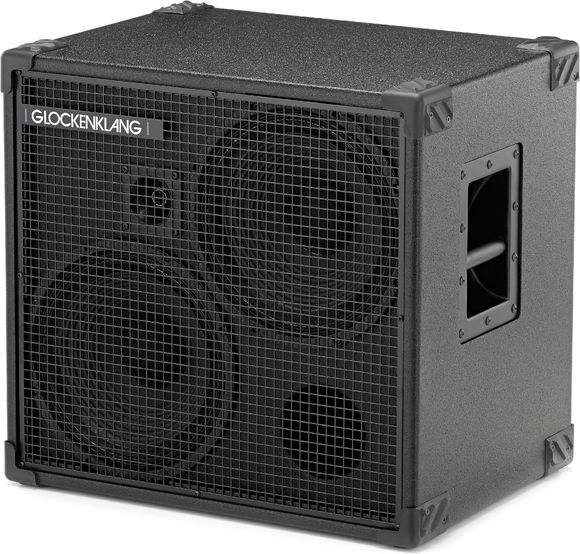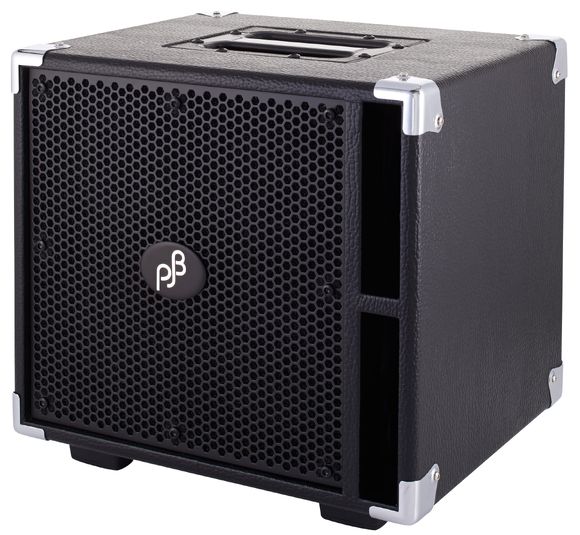4. Which speakers are featured in bass cabinets?
Let's have a look at the type of speakers that have become standard in bass cabs. The first thing you need to know in this context is that the size of speakers is indicated in inches even in countries that are otherwise metric. Over the years, 10-inch, 12-inch and 15-inch speakers have become the most common. Every size of speaker supposedly imparts a particular "shade" to the sound.
Ten-inchers:
Ten-inch speakers are said to be especially agile and rich in attack when rendering the bass signal. It is therefore not surprising that this speaker type is often chosen by bass players who are seeking a detailed sound and play styles of music where the bass should be clearly distinguishable, at the forefront of band's sound, so to speak. Players who incorporate techniques such as slapping or tapping, or who prominently feature plectrum playing will be well served by these speakers.
Conversely, such speakers are supposed to labour under a handicap, namely that their relatively small diameter makes it impossible for them to supply powerful bass "all the way from the bottom". To put fears of too little bass power to rest, many equipment manufacturers have chosen put several ten-inchers into a single cabinet. In practice, the most commonly found cabinets include either a single ten-incher (favoured e.g. for mini bass combos, for quiet rehearsing and performances with small bands or in small venues), to of them or even four.
In fact, this last 4x10 bass cab can be considered THE standard bass cab in the bass player scene globally, since the four times larger membrane surface creates a great balance between a tight attack and good bass punch. Cabinets with six or even eight speakers can also be found, though much less frequently - most often with famous bands on large stages or at festivals. Of course, such cabinets produce great sound, but as far as their weight and portability are concerned, they are beyond the dimensions practical for hobby musicians and semi-professionals.
Hint: two 4x10 cabinets stacked on top of each other feature the same membrane surface as an 8x10 cab. But the two cabs are much easier to handle separately - especially when you don't have roadies to rely on!
Twelve-inchers:
They are often unjustifiably overshadowed by the "supremely reigning" ten-inchers and the 15-inchers we'll be discussing below, and this despite the fact that bass cabs featuring 12-inch speakers are an absolute insider tip among aficionados. The reason is this: speakers of this size still react very rapidly to a wide variety of playing techniques and style while at the same time possessing powerful basses and a very pleasantly warm sound. Fretless bass players in particular tend to go all in for these speakers' mid-range punch which perfectly supports the vocal sound of a fretless instrument. Depending on your budget and your taste, single-speaker cabinets are an option, but many also come with two speakers (and a few with four). Since the dimensions of a four-speaker cabinet are considerable, however, the two-speaker and single-speaker configurations have become the standard.

This Glockenklang bass cabinet features two 12" speakers arranged on the diagonal and a tweeter.
Fifteen-inchers:
In the 1970s, these were the first choice for most bass cabinets: the enormous 15-inch speakers gave powerful, pumping bass all the way "from the bottom". In the 1980s, however, they almost became speakers non gratae thanks to the dominance of the slapping technique in the musical styles back then, for which the less nimble 15-inchers were less suitable. You should also be aware of the fact that transformative developments have occurred in speaker technology since then. Consequently, there are ten-inchers available nowadays that provide unsuspected bass power, and likewise fifteen-inchers that are anything but lethargic. Only the basic characteristics have remained: 15-inchers come into their own most fully in massive deep basses, such as those you'll find in reggae or blues. Usually, a single cabinet can hold only one or two of these speakers.
Rarities:
It would be very surprising indeed had no manufacturer ventured into the more unusual speaker cabinet configurations in the last decades. Indeed, there has been much experimentation in this area, and experimentation in fact continues. In the last few years, there have been three internationally renowned manufacturers in particular who caused a stir with unusually arranged bass cabinets: Markbass, TecAmp, and - most prominently - Phil Jones Bass (PJB). Several models in the Markbass lightweight-construction series have featured 8" speakers to make the cabinets lighter and smaller. This Italian company has even experimented with coaxial cabinets, which have not achieved success on the market, however. This space-saving construction usually features bass speakers and tweeters arranged on top of each other in a chassis, something you can find frequently in HiFi or car speaker systems. German company TecAmp's "Bad Cab" has gained attention over the past few years. This is a truly enormous speaker cabinet, featuring two fifteen-inchers, two tvelve-inchers, four ten-inchers as well as two NTW1 tweeters.
US manufacturer Phile Jones pursues what they call a "Piranha Principle", arguing that many small components put together can also achieve resounding success. Their boxes therefore feature large numbers of small, i.e. five-inch speakers. The PJB 21B, for example, contains 21 (!) speakers in total. This unusual concept is actually successful - but you won't want to carry those cabinets around, especially not by yourself!

This Phil Jones Pianha Cabinet features four small 5" speakers, which together achieve a mighty powerful sound.
Just as there are "miniature" versions of the standard speakers, there are also developments that go in the opposite direction: 18" speakers provide a profound bass power that you could probably use to communicate with elephants or whales! While such speakers were relatively common in the 1970s and 1980s, there are smaller-diameter speakers available today which deliver similarly well-developed deep basses - and therefore there are hardly any manufacturers left who put 18-inchers into their cabinets. 18" speakers are, in addition, regarded as too lethargic to cope well with the modern, attack-focussed playing techniques popular these days.
Tweeters:
Bass players became much more demanding the 1980s, in particular. While many bass players in the 1960s and 1970s made do with a growly valve amp and frequently just any old speaker cabinet, the next decade saw them encounter vinyl productions whose bass tracks were often laid down by keyboards sounding extremely crisp and clear. This development, as well as the resurrection of slap bass playing by bands such as Level 42 led not only to novel instruments (better pickups, graphite as a material, etc) and amps (heyday of solid state amps with multiple-band EQs, etc.), but also to new types of bass cabinets. These were designed to let the e-bass take centre stage sound-wise. The treble speakers, also called tweeters, were part of this development. Their purpose was to render those frequencies perceived as particularly clear and brilliant better audible, so that overtones (string harmonics) or hard slaps and pops employed by the bass player would fully come into their own.
Tweeter ensure this clarity and balance in the frequency spectrum to this very day, and some clever manufacturers have even found ways to make tweeters even more variably useful. Instead of determining the share of the higher frequencies exclusively in the instrument's sound controls or in the amp EQ, many modern bass speakers feature adjustable tweeters - or at least a tweeter on/off switch. While there are bass players who really do not enjoy the sound of a tweeter (world-famous virtuoso Jeff Berlin being one of them!), only having a continuously adjustable tweeter at your disposal affords you maximum flexibility.
Speakers with this feature usually have a small controller on the rear connector panel which allows the player to determine the share that the tweeter has in the speaker's overall sound. Less often, this control is attached to the side of the speaker, for example in the recess of the speaker's carrier handle. So, if you want maximum flexibility and versatility, you should make sure that the speaker you decide to buy has this feature. The difference between two 15-inchers, one with, and the other without a tweeter, is absolutely enormous!




